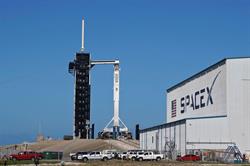Falcon 9, Cargo Dragon Arrive On Pad 39A for Saturday Launch Written 3 December 2020
In This Section

A SpaceX Falcon 9 rocket sits on the launch pad at Launch Complex 39A, Nov. 13, 2020, Cape Canaveral, FL. | Credit: Chris O’Meara; Associated Press–©
Spaceflight Now reports that a SpaceX Falcon 9 rocket was moved to pad 39A Wednesday “for the first launch of an upgraded version of the company’s Dragon cargo capsule for the International Space Station.” SpaceX will test-fire the main engines Thursday to prepare for the launch scheduled for Saturday at 11:39 EST. The Dragon cargo capsule “is scheduled to dock with the International Space Station’s Harmony module zenith port at 11:30 a.m. EST (1630 GMT) Sunday, delivering 6,553 pounds (2,972 kilograms) of supplies, experiments, and a new commercial airlock module to the orbiting research complex.”
Full Story (Spaceflight Now)
